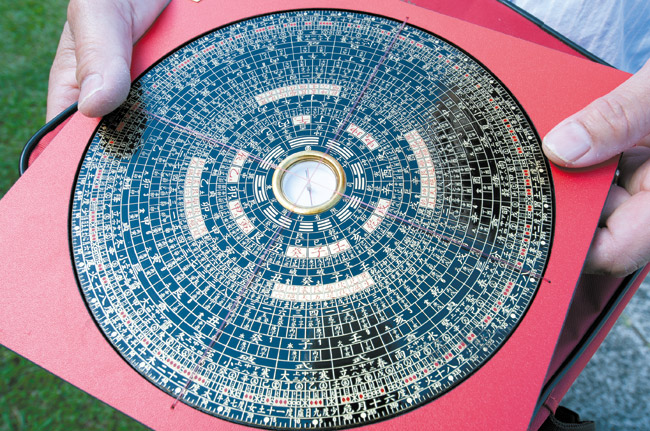Feng Shui: Finding Balance
Crouching tiger” and “hidden dragon” aren’t just slick Asian martial arts terms. Tiger and dragon represent the balance between yin and yang, or masculine and feminine energies. And feng shui, a practice that relies on the yinyang concept, might conjure up nebulous ideas of properly placed hanging plants, a glowing Oriental lantern and, perhaps, the soothing trickle of an indoor fountain. But this ancient practice has deep roots and is connected to other disciplines, such as Chinese astrology. At the dawn of Year of the Ram, local feng shui expert Alan Lum shares insight on the feng shui elements involved in setting up the most auspicious living environment.
“Feng shui,” he says, means “‘wind-water.’ It’s the idea of balance. What you want is a balance of good energies around the environment that you’re living in.”
Though from a Chinese family, like most people, Lum had limited understanding of the custom until 1996, when his parents demolished their Honolulu home. Before rebuilding, they called in a feng shui practitioner. Lum, who has degrees in religion and social work, was so enthralled that he researched the art, eventually studying under a master. Since 2002, he’s been consulting homes and businesses (284-4664, alanlum@hawaii.edu), and he teaches both feng shui and Chinese astrology in the UH college system.
Standing at Manoa Chinese Cemetery, he points out a mountain range that rises behind the cemetery and stretches out on both sides of it. The high point in back is called Turtle. The right-hand range is Tiger ― “yin, female, passive, subtle, receptive energy,” says Lum ― and the left-hand range is Dragon, “yang, male, active, bright, solid, firm energy.”
Turtle represents health, so together “the mountains represent support and health for the home,” says Lum.
In the center of the cemetery, two Chinese lions symbolically mirror the configuration, with a female holding a cub on the right and a male, his paw resting on a ball, on the left.
“This even applies to the bedroom,” notes Lum.
“Traditionally, the male would be on the left side and the female would sleep on the right.”
To complete the ideal setup, the plot should face a body of water contained by a small hill or Phoenix. The contained water represents acquirement of wealth. In this case, the water is the Ala Wai and a modern hybrid of ideas allows the Waikiki skyline to stand in as the hill.
“People think water is more important, but no, the mountain in the back is, because that represents health,” points out Lum. “If you have this ideal land site for your home, that would be great. If not, you can simulate it in your yard, by planting trees in the back to represent the turtle, and some on the side. In the front, you want (the hedges) more low, because you want to see the opportunities coming in.”
In fact, a tree right in front is a big no-no as it blocks good things from entering. When it comes to the inside of the house, a staircase leading straight to the front door also is bad form, as it allows all the positive energy in the home to flow right out.
“(Setting up cemeteries in auspicious places) may have started partly because of looking for good feng shui sites for the deceased,” says Lum. “If they felt that the deceased had a good burial site, then that positive energy would flow down to the later generations.”
Moving inside the home space, things become infinitely more complex. A ceremonial compass wrought with elaborate markings helps map out nine directions or energies in the home, from positive features like prosperity, academic or promotion energy, to negative ones like sickness or conflict energy. The location of these energies within the home takes into consideration the time period in which the home was built ― based on 20-year segments ― and the direction the home is facing, and each of the nine directions is further divided into three sectors. You get where this is going … A lot of ascertaining goes into creating a balanced living space, and to get even more esoteric, those energies are in flux. Energies also have certain positive or negative interactions with elements.
Say you’re concentrating on academics: “Academics is related to wood, so we want to introduce more of the water element, because water enhances wood,” says Lum. “It’s not a blanket for every house, but we have to look at each house. Just like each individual when they go to the doctor.”
Another example comes up with colors, like red, which is generally associated with good fortune:
“The color red is good, but for feng shui, it depends where you put the red. If you have sickness energy, you don’t want red there because red is fire and sickness energy is earth. Fire enhances earth.”
For a further glimpse into feng shui, Professional Women’s Network has invited Lum to speak at its Feb. 26 luncheon and the public is invited to attend (email reservations@pwnhawaii.org for cost and location). Lum will speak about feng shui, highlighting prosperity in the workspace.
Lum explains that in Chinese culture, even today, feng shui remains an integral practice. For instance, people commonly consult feng shui practitioners and astrologers when decorating or remodeling the home, or to check for relationship compatibility or for a heads-up about what to expect in the new year.
May this Year of the Ram be one of balance and prosperity.






